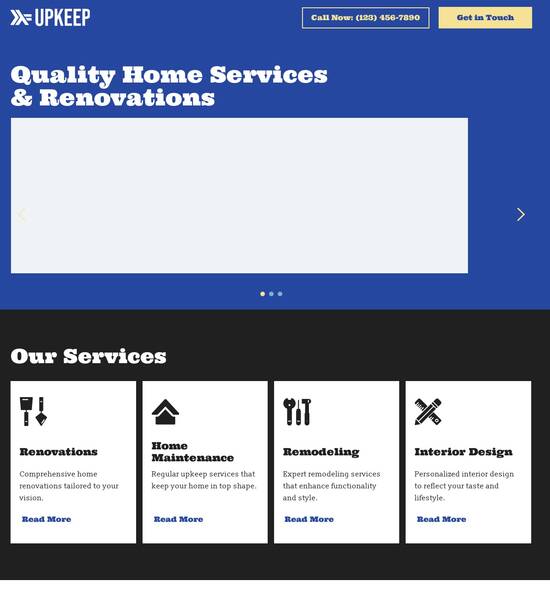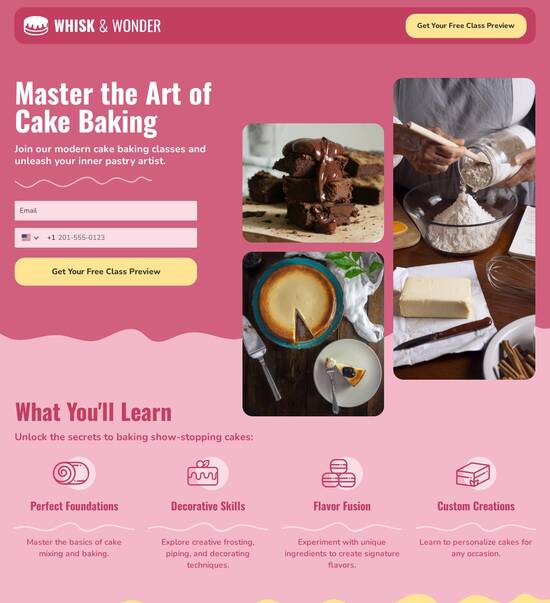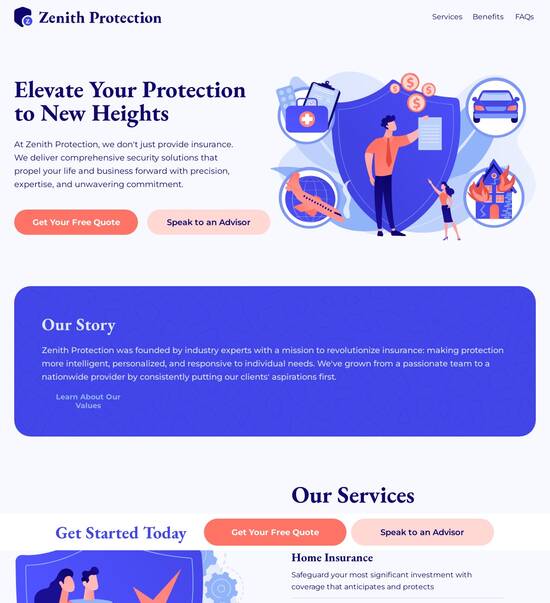
403 forbidden page template optimized for Android phone
Explore Similar TemplatesAbout template
Design using a responsive 403 forbidden page template that delivers a flawless experience on Android phone. Try Instapage today!
Recommended templates

Easy to build without coding
With the intuitive drag-and-drop builder, anyone on your team can create high-converting pages without any knowledge of code or design. Make enhancements to your landing page with custom widgets using Javascript, HTML/CSS, or third-party scripts.

Multiple layouts for any industry and goal
Select from 500+ landing page layouts built to boost conversions across industry-specific scenarios. Customize them by adjusting fonts, adding images, and generating on-brand content with the AI assistant. Quickly scale with Instablocks® and Global Blocks that you can save, reuse, and update globally.

Loads fast and looks polished on any device
Every template is responsive, which means they present professionally on any device and load blazingly fast with our Thor Render Engine. You can also power them up with Google AMP technology to deliver an unparalleled mobile experience and drive higher conversions.

Robust analytics & experimentation
Get real-time updates and reporting across all your devices, showing the number of visitors, conversions, cost-per-visitor, and cost-per-lead. Launch AI-powered experiments, run A/B tests, and use heatmaps to analyze user behavior, then optimize your landing page to maximize conversions.







Easy to build without coding
With the intuitive drag-and-drop builder, anyone on your team can create high-converting pages without any knowledge of code or design. Make enhancements to your landing page with custom widgets using Javascript, HTML/CSS, or third-party scripts.
Multiple layouts for any industry and goal
Select from 500+ landing page layouts built to boost conversions across industry-specific scenarios. Customize them by adjusting fonts, adding images, and generating on-brand content with the AI assistant. Quickly scale with Instablocks® and Global Blocks that you can save, reuse, and update globally.
Loads fast and looks polished on any device
Every template is responsive, which means they present professionally on any device and load blazingly fast with our Thor Render Engine.
Robust analytics & experimentation
Get real-time updates and reporting across all your devices, showing the number of visitors, conversions, cost-per-visitor, and cost-per-lead. Launch AI-powered experiments, run A/B tests, and use heatmaps to analyze user behavior, then optimize your landing page to maximize conversions.
All the features you need to build lead-generating landing pages
Explore more featuresLearn how to build top-performing landing pages for any goal
FAQs
Leading the way in building high-performing landing pages





A comprehensive guide to creating an optimized 403 forbidden page template for Android phones
Creating a 403 forbidden page template optimized for Android phones is critical for maintaining a seamless user experience. Instapage provides a robust solution to design captivating landing pages that not only appeal aesthetically but also serve functional purposes, including managing access denial effectively.
Understanding the 403 Forbidden Error
The 403 Forbidden error occurs when the server understands the request but refuses to authorize it. This commonly happens due to permission settings or user access restrictions. A well-designed 403 page can help communicate this error clearly to users while maintaining your brand's integrity.
- Clarifies access issues to prevent user frustration by giving specific reasons—such as permission errors or lack of authentication.
- Maintains a professional appearance aligning with your brand identity, allowing for custom messaging and design.
- Provides navigation options back to the homepage or other helpful resources, effectively guiding user flow even during an error.
Step 1: Choose a Template on Instapage
Start by selecting a suitable template on Instapage that aligns with your brand. With access to over 100 high-converting templates, you can ensure a professional look that is optimized for mobile devices.
Step 2: Customize Your 403 Page Content
After selecting the template, focus on tailoring the content. Consider these key elements:
- Add a clear, concise message explaining the 403 error, ensuring users understand they are not authorized for access.
- Include your brand's logo and color scheme to maintain consistency, reinforcing brand recognition.
- Implement links to the most visited pages or a search function to assist users in navigating your website.
Step 3: Optimize for Mobile Users
Given the prevalence of mobile device usage, ensure your 403 page is fully responsive and looks appealing on Android phones. This includes testing font sizes, button placements, and ensuring fast load times.
- Scale images and fonts appropriately to make them readable on smaller screens without horizontal scrolling.
- Utilize Instapage's responsive design options to accommodate various screen sizes automatically.
- Run performance tests to confirm quick loading times, which improve overall user experience and reduce bounce rates.
In conclusion, a well-crafted 403 forbidden page template not only resolves access issues but also strengthens user interaction by keeping branding consistent and enhancing navigation.
Don't leave your users in the dark—create an engaging and informative 403 forbidden page optimized for Android devices with Instapage today. Start enhancing your user experience now!
People also ask about 403 forbidden page template optimized for Android phone
403 Forbidden page template optimized for Android phone
Understanding the significance of a 403 forbidden page
The 403 Forbidden error is a notable HTTP status code that indicates that the server understands the request made by the client, but it is refusing to authorize it. Essentially, this means that the user does not have the necessary permissions to access the requested resource. This error can arise due to various reasons, such as restricted permissions set by the website owner, IP blocking, or incorrect file permissions. For users encountering this error, it can be a frustrating experience, often leading them to think there’s something wrong with the webpage or their connection.
Common scenarios leading to a 403 Forbidden error include inadequate directory permissions and the presence of .htaccess rules that disallow access. Understanding these reasons is essential to address the underlying issues effectively. Well-designed error management and user experience strategies can mitigate frustration by providing clear communication about why access was denied and suggesting next steps.
As user experience plays a vital role in retaining visitors, handling errors efficiently is crucial. An error page that informs the user and offers solutions can prevent them from leaving the site altogether.
The user experience impact
A 403 Forbidden page can significantly frustrate users, especially if they are unsure why they cannot access a page they were expecting to view. Poor error handling can negatively impact a website's usability. Users may associate a bad experience with a website, which can lead to decreased traffic and engagement over time. Therefore, understanding the ramifications of a 403 error is essential for any site owner.
Statistics indicate that a significant number of users abandon websites after encountering an error page without proper guidance on how to proceed. This makes it vital to design a 403 page that not only informs but also engages users and directs them towards other useful resources or content.
Crafting an optimized 403 forbidden page template for Android users
When designing a 403 Forbidden page, mobile optimization is crucial, particularly given the prevalence of Android devices. Users accessing a website via their smartphones expect content to rearrange seamlessly. Ensuring that your page displays well involves responsive design principles that accommodate various screen sizes.
Prioritize font size and clarity, ensuring that text is easily readable without excessive zooming or scrolling.
Ensure buttons are adequately sized for fingers to tap without difficulty, enhancing navigation.
Optimize images to scale conveniently, keeping load times minimal while maintaining quality.
Furthermore, testing your mobile display methods on various Android devices is essential for ensuring a consistent user experience that minimizes frustration.
Striking the right tone: messaging and content
When a user encounters a 403 Forbidden error, it’s essential to maintain an empathetic tone. An error message that acknowledges the issue while prompting users to explore alternative resources is vital. Examples of engaging copy could include simple phrases like, 'Oops! You don’t have permission to view this page, but here’s what you can do next.'
Incorporating humor or personality in error messages can also help alleviate user frustration, making the experience slightly more enjoyable. Striking this balance is crucial to foster a connection with your users.
Enhancing accessibility and aesthetic appeal
To create a well-balanced 403 Forbidden page, visual elements play a crucial role. Opt for simple, user-friendly color schemes that promote clarity and minimize distraction. For example, using bright colors for calls-to-action in contrast with a muted background can help guide users effortlessly.
Additionally, choose user-friendly images that communicate the error effectively, perhaps using illustrations or icons that point to alternative navigation options. A well-structured design template must reflect your brand identity while adequately addressing the error.
Storage solutions for efficient load times
Loading times can significantly affect user experience, particularly on mobile networks. Optimizing images and content for faster download speeds is essential. Compressing images without sacrificing quality can expedite loading times, enhancing accessibility.
Leveraging cloud storage technologies can also help retain page performance while enabling faster access to resources. This can significantly reduce storage-related hindrances, particularly during unexpected traffic spikes.
Implementing functional features for better user navigation
A functional 403 Forbidden page should provide users with helpful links and resources. Incorporating links to related articles, FAQs, and support contact information allows for an easy transition back to the main site or direct assistance. This not only enhances user navigation but also builds goodwill.
Providing location-based resources to assist users in finding relevant information more efficiently.
Integrating breadcrumbs can help users trace their path back to where they initially started, saving time and reducing confusion.
The end goal is to ease user frustration and repurpose their experience positively, even in the face of a 403 error.
Utilizing feedback mechanisms
Offering users the option to report problems or to provide feedback directly on the 403 page is vital. Establishing a channel for collecting user questions aids in refining the message displayed, providing clarity, and eliminating recurring issues. This feedback can be instrumental in continuously optimizing the error page.
Additionally, creating space for community support or forums to discuss access issues can transform a frustrating moment into an opportunity for engagement. Here, users could share their experiences and potentially find solutions while interacting with others.
Leveraging technology to optimize the 403 page experience
Modern technologies can greatly enhance the user experience on a 403 Forbidden page. For instance, implementing AI chatbots can provide users with real-time guidance on what actions to take next, making the experience more interactive and engaging.
Utilizing analytics to track instances of 403 errors can help identify common access issues and user interactions, feeding valuable insights for continuous improvement. Additionally, incorporating machine learning can help predict what users need or will inquire about after encountering such errors, optimizing response strategies.
Collaboration with teams for continuous improvement
To maintain an effective 403 page, collaboration between content and tech teams is vital. Regular updates based on user feedback ensure that the page stays relevant and functional. Creating feedback loops that collect community insights also strengthens the response to access issues, allowing both teams to work cohesively towards a solution.
Sharing knowledge and solutions cross-department can foster a culture of collective problem-solving that ultimately benefits user experience and site functionality.
Showcasing previews and visual feedback
Previewing the 403 Forbidden page across different devices is essential for ensuring a consistent experience. Techniques for A/B testing various designs and messages can provide insights into what resonates best with users. Collecting data on user interactions with the page can shape future iterations.
Sharing success stories and performance metrics that illustrate improved user retention after implementing changes can also encourage practices that enhance user experience across the entire website.
The benefits of a well-designed 403 forbidden page
A thoughtfully designed 403 Forbidden page can transform a negative experience into an opportunity for user retention and brand loyalty. By focusing on user data and understanding common pain points, websites can create content strategies to address these hurdles proactively, keeping users engaged even in moments of frustration.
Positioning the 403 page as a tool for community-building enhances transparency and trust, showing users that their experience is valued and that solutions are continually sought.
Future considerations and innovations
As user needs evolve, so must the strategies employed in managing access issues. Anticipating changes in user behavior and technology utilization will play an essential role in refining the 403 Forbidden page experience. Potential innovations such as integrating augmented reality or other interactive elements may soon become a part of error page strategies.
Ongoing user feedback will be crucial in shaping these developments, ensuring that the primary focus remains on delivering an enhanced and supportive user experience even in challenging situations.
Building a stronger connection with users
Aligning the purpose of the 403 Forbidden page with broader business goals fosters an enriched approach to user engagement. It's key to encourage transparency and open communication, creating a dialogue with users that reinforces their relationship with the brand. This community-minded approach ultimately transforms access issues into opportunities for customer engagement and satisfaction.
Ready to skyrocket conversions?
Supercharge your ad campaigns with high-performing landing pages
Get started














